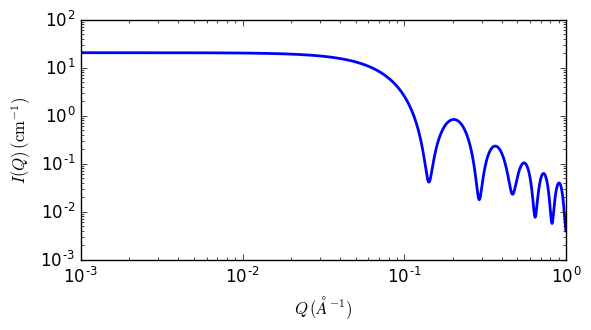hollow_rectangular_prism_thin_walls
Hollow rectangular parallelepiped with thin walls.
| Parameter | Description | Units | Default value |
|---|---|---|---|
| scale | Source intensity | None | 1 |
| background | Source background | cm-1 | 0.001 |
| sld | Parallelepiped scattering length density | 10-6Å-2 | 6.3 |
| sld_solvent | Solvent scattering length density | 10-6Å-2 | 1 |
| length_a | Shorter side of the parallelepiped | Å | 35 |
| b2a_ratio | Ratio sides b/a | Å | 1 |
| c2a_ratio | Ratio sides c/a | Å | 1 |
The returned value is scaled to units of cm-1 sr-1, absolute scale.
This model provides the form factor, \(P(q)\), for a hollow rectangular prism with infinitely thin walls. It computes only the 1D scattering, not the 2D.
Definition
The 1D scattering intensity for this model is calculated according to the equations given by Nayuk and Huber (Nayuk, 2012).
Assuming a hollow parallelepiped with infinitely thin walls, edge lengths \(A \le B \le C\) and presenting an orientation with respect to the scattering vector given by \(\theta\) and \(\phi\), where \(\theta\) is the angle between the \(z\) axis and the longest axis of the parallelepiped \(C\), and \(\phi\) is the angle between the scattering vector (lying in the \(xy\) plane) and the \(y\) axis, the form factor is given by
where
and
The 1D scattering intensity is then calculated as
where \(V\) is the volume of the rectangular prism, \(\rho_\text{p}\) is the scattering length of the parallelepiped, \(\rho_\text{solvent}\) is the scattering length of the solvent, and (if the data are in absolute units) scale represents the volume fraction (which is unitless).
The 2D scattering intensity is not computed by this model.
Validation
Validation of the code was conducted by qualitatively comparing the output of the 1D model to the curves shown in (Nayuk, 2012).

Fig. 56 1D plot corresponding to the default parameters of the model.
References
R Nayuk and K Huber, Z. Phys. Chem., 226 (2012) 837-854